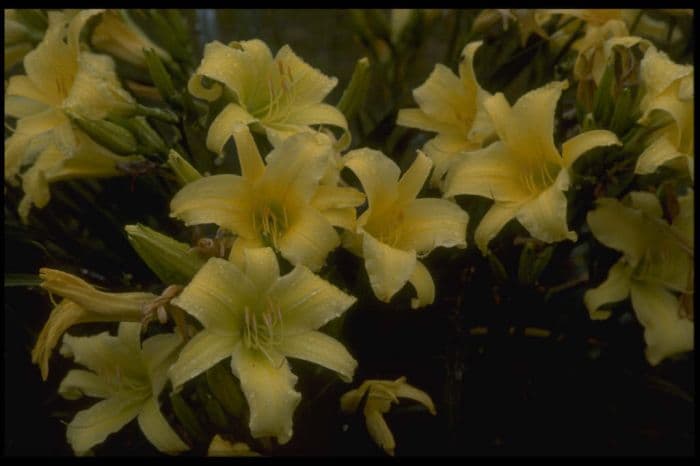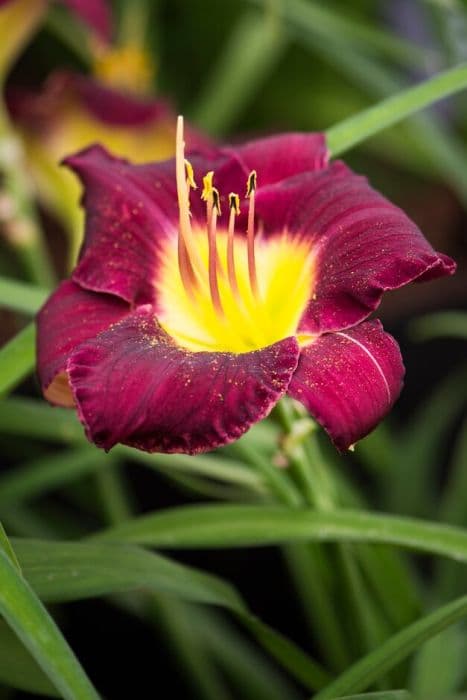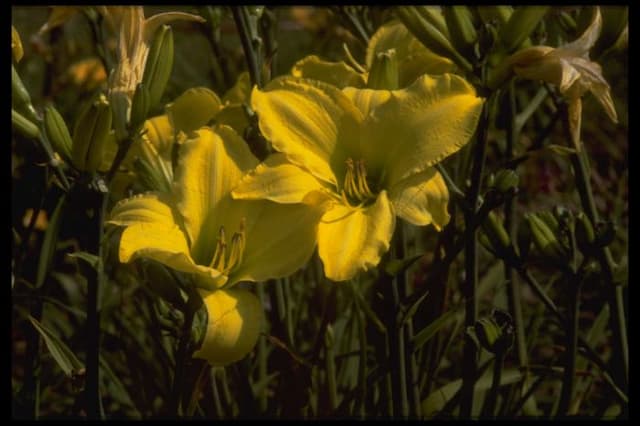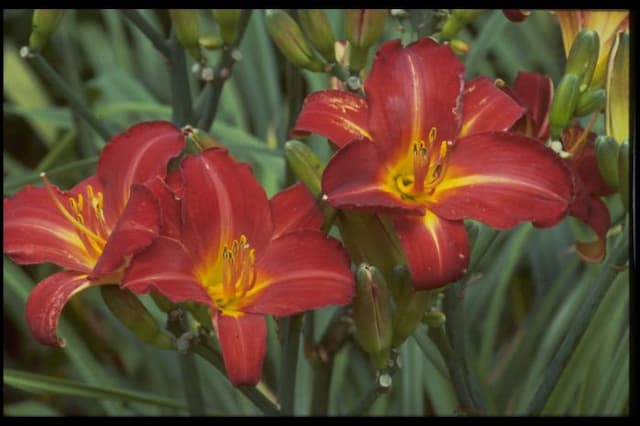Daylily Hemerocallis 'Nova'

ABOUT
Hemerocallis 'Nova', also known as the daylily 'Nova', is a perennial plant with a striking appearance. It features a clump of arching, blade-like leaves that form a lush, grassy mound. The foliage is typically bright green and may have a slightly glossy texture, providing a verdant backdrop for the flowers. The most captivating feature of the daylily 'Nova' is its blooms, which are known for their vibrant colors and large, trumpet-shaped structure. These flowers appear on long, slender stalks that rise up from the foliage, creating an impressive display when the plant is in full bloom. The blooms of this daylily can vary in color, often showcasing shades of yellow, orange, pink, red, or purple, sometimes with a different colored throat or striking patterns on the petals. Each flower consists of six petal-like segments, three outer sepals and three inner petals, that spread outwards to form a circular shape. The center of the flower, known as the throat, may contrast with the petals in color and often features a different hue that draws attention to the inner part of the bloom. Pollen-bearing anthers sit atop slender filaments, adding a touch of elegance. The stigmas extend gracefully, completing the structure of the flower. Daylily 'Nova' blooms are notable for their one-day lifespan; each flower typically only lasts for a single day, with new flowers opening up to take their place during the blooming period. This characteristic of opening and closing within a day's time frame is what gives the daylily its common name. Despite the brief individual flower's duration, the plant produces numerous buds, ensuring a continuous display of blossoms throughout the blooming season. Overall, the daylily 'Nova' is renowned for its hardiness, its ability to produce an abundance of blooms, and the enchanting beauty of its flowers, which add a burst of color and charm to gardens and landscapes.
About this plant
 Names
NamesFamily
Hemerocallidaceae
Synonyms
Daylily
Common names
Hemerocallis 'Nova'.
 Toxicity
ToxicityTo humans
Hemerocallis 'Nova' is commonly known as the Daylily. Daylilies are not considered toxic to humans and are even consumed in some culinary traditions. The flowers and tubers are edible when properly prepared. However, as with any plant, individual allergies and sensitivities could result in mild gastrointestinal discomfort if ingested, but this is not commonly reported.
To pets
The Daylily is known to be toxic to cats and can cause severe kidney damage. Even small amounts of any part of the plant, if ingested by a cat, can lead to symptoms such as vomiting, lethargy, and lack of appetite. If a cat consumes part of a Daylily, it is considered a veterinary emergency. Cats may require immediate medical attention, as the consumption of Daylilies can be potentially fatal.
 Characteristics
CharacteristicsLife cycle
Perennials
Foliage type
Deciduous
Color of leaves
Green
Flower color
Varies
Height
2 feet (0.61 meters)
Spread
2 feet (0.61 meters)
Plant type
Herb
Hardiness zones
3-9
Native area
Asia
Benefits
 General Benefits
General Benefits- Easy to Grow: Hemerocallis 'Nova', commonly known as Daylily, is known for its adaptability and ease of care, making it suitable for gardeners of all skill levels.
- Drought Tolerance: Daylilies are drought-resistant once established, requiring minimal watering and making them ideal for low-water gardens.
- Pest Resistance: Daylilies are generally resistant to most pests and diseases, reducing the need for chemical treatments.
- Variety of Colors: They come in a wide range of colors, allowing for versatile design and color schemes in the landscape.
- Attracts Pollinators: The flowers are attractive to butterflies and bees, promoting pollinator activity in the garden.
- Long Blooming Season: Daylilies have a long flowering period, often blooming from early summer until fall, providing prolonged visual interest.
- Edible Parts: Certain parts of the daylily are edible, with flowers that can be used in culinary dishes.
- Soil Stabilization: The root system of daylilies helps prevent soil erosion, making them a practical choice for sloped areas and garden banks.
- Low Maintenance: Once established, daylilies require very little maintenance, which includes deadheading, division, and minimal feeding.
- Propagates Easily: They can be easily propagated by division, allowing gardeners to expand their collection or share with others.
 Medical Properties
Medical Properties- This plant is not used for medical purposes.
 Air-purifying Qualities
Air-purifying QualitiesThis plant is not specifically known for air purifying qualities.
 Other Uses
Other Uses- Hemerocallis 'Nova', commonly known as daylily, can be used in natural dye production. The flowers, particularly the deep red and purple varieties, can yield dyes for fabrics.
- Daylilies are often used for erosion control due to their extensive root system which helps stabilize soil on slopes and embankments.
- In some cultural practices, daylily blooms are used for decorative purposes in ceremonies or traditional garb, representing good fortune and success.
- Daylily buds are sometimes used in fish tanks or ponds as natural fish food, as they are edible and nutritious for some species.
- The fibrous roots of daylilies can be utilized in making sustainable, biodegradable pots or planters for other plants.
- The robust growth of daylilies can make them useful as a living mulch, suppressing weeds and retaining soil moisture in garden beds.
- Certain artists use daylily petals as a natural source for pigments in botanical watercolor paints.
- Daylilies can be inter-planted with vegetable crops to attract beneficial insects that prey on common garden pests.
- Daylily leaves can be incorporated into handcrafted papers, adding texture and visual interest to the finished product.
- The thick foliage of daylilies can act as a habitat for small beneficial creatures like frogs and toads, providing them with shelter and a place to hunt insects.
Interesting Facts
 Feng Shui
Feng ShuiThe Daylily is not used in Feng Shui practice.
 Zodiac Sign Compitability
Zodiac Sign CompitabilityThe Daylily is not used in astrology practice.
 Plant Symbolism
Plant Symbolism- Beauty: Hemerocallis, commonly known as the Daylily, symbolizes beauty due to its striking colors and graceful shape.
- Motherhood: In Chinese culture, daylilies are a symbol for motherhood and fecundity because of their ability to produce numerous offspring, or buds.
- Transience: The Daylily’s individual flowers typically only last for one day, representing the ephemeral nature of life.
- Forgiveness: Their brief blooming period can also stand for forgiveness, suggesting that one should forgive quickly as life is short.
- Renewal: Despite the short lifespan of each bloom, daylilies continue to produce new flowers, symbolizing renewal and the continuity of life.
 Water
WaterDaylilies, like the Hemerocallis 'Nova', should be watered deeply about once a week, providing 1 to 1.5 inches of water which should be enough to soak the top 8 to 10 inches of soil. During the peak of summer or in particularly hot climates, watering frequency may need to increase to twice a week. Always check the soil moisture level before watering; if the soil is still moist, delay watering. Overhead watering can be avoided to prevent leaf spot diseases; instead, use drip irrigation or soaker hoses to deliver water directly to the root zone. Avoid overwatering as this can lead to root rot, particularly in poorly drained soils.
 Light
LightDaylilies thrive in full sunlight, so Hemerocallis 'Nova' should be planted in an area where it can receive at least six hours of direct sun each day. Partial shade is also acceptable, especially in regions with very hot summers, but too much shade can reduce blooming. Avoid heavily shaded areas which can lead to stunted growth and fewer flowers.
 Temperature
TemperatureHemerocallis 'Nova' is a hardy plant, withstanding temperatures ranging from about -20 to 90 degrees Fahrenheit. The ideal temperature range for daylilies is between 60 and 75 degrees Fahrenheit. They enter a dormant period once the temperature starts to dip below 50 degrees, so they can survive cold winters and will re-emerge in the spring.
 Pruning
PruningDaylilies, such as the Hemerocallis 'Nova', should be pruned to remove spent flowers and flower stalks to encourage new blooms and maintain plant vigor. Deadheading the flowers as they fade can also prevent the plant from using energy to produce seeds. The best time to prune daylilies is in the late fall or early spring, when you can also cut back any dead foliage from the previous season.
 Cleaning
CleaningAs needed
 Soil
SoilDaylilies (Hemerocallis 'Nova') thrive in well-draining soil with a slightly acidic to neutral pH, ranging from 6.0 to 7.0. A good soil mix for daylilies could include a blend of loamy garden soil, compost, and a small amount of sand to enhance drainage. Ensuring that the soil is fertile and rich in organic matter will support vigorous growth and abundant flowering.
 Repotting
RepottingDaylilies, like Hemerocallis 'Nova', typically do not need frequent repotting since they are grown outdoors in the ground. These plants can be divided every 3 to 5 years to manage their size and maintain vigor, or when the clumps become dense and blooming diminishes. Repotting is more relevant for daylilies grown in containers, which should be done when they outgrow their current pot or every few years.
 Humidity & Misting
Humidity & MistingDaylilies, commonly known as Hemerocallis 'Nova', are not particularly sensitive to humidity levels and can tolerate a wide range. These robust perennials do well in average outdoor humidity conditions. As long as daylilies are planted in well-draining soil and receive appropriate watering, the ambient humidity typically does not impact their health or flowering.
 Suitable locations
Suitable locationsIndoor
Bright light, well-draining soil, keep at room temp.
Outdoor
Full sun to part shade, well-draining soil, regular watering.
Hardiness zone
3-9 USDA
 Life cycle
Life cycleThe life of the Hemerocallis 'Nova', commonly known as a Daylily, begins with seed germination, where seeds establish in well-draining soil and sprout within weeks or months, depending on conditions. Seedlings grow into juvenile plants, developing a rosette of strap-like leaves and a root system. As the plant matures, it enters a vegetative stage, during which it increases in size and foliage. The next significant stage is the flowering phase, where the Daylily produces numerous buds that bloom into vibrant flowers, typically occurring in early to mid-summer, with each blossom lasting just a day. After flowering, seeds develop in pods and, when mature, are released to begin the cycle anew or the plant enters into a period of dormancy in colder climates, where it conserves energy until the return of favorable growth conditions in spring. Throughout its life cycle, the Daylily may also expand through rhizomatous growth, creating clonal offshoots that develop into new, genetically identical plants.
 Propogation
PropogationPropogation time
Early spring
The Hemerocallis 'Nova', commonly known as a Daylily, is typically propagated by division, which is the most popular method for this plant. The best time to propagate Daylilies by division is early spring or immediately after flowering in late summer or fall. To propagate by division, carefully dig up the clump of daylilies, ensuring that you keep a good portion of the roots intact. Gently pull the clump apart into smaller sections, each with two or three fans of leaves and a portion of the root system. Replant the divisions immediately at the same depth they were growing, spacing them about 18 to 24 inches (approximately 45 to 60 centimeters) apart to allow for growth. Water the newly planted divisions thoroughly to help establish them. This method leverages the naturally clumping habit of Daylilies to create new plants that will mature and flower in subsequent seasons.









